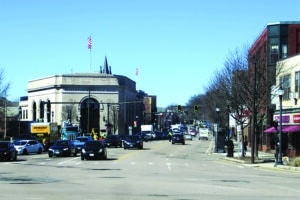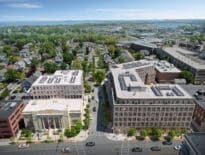
A proposed rezoning of Watertown Square to comply with the MBTA Communities law could generate construction of 2,600 housing units, many on parking lots surrounding commercial properties. Photo by Steve Adams | Banker & Tradesman Staff
While resistance to the MBTA Communities law makes headlines in some Boston suburbs, others have devised proposals that would not only meet the state’s housing production goals, but exceed them by thousands of units.
In Watertown Square, consultants recommend zoning areas around the square for building heights ranging from three to five stories, with the tallest heights near the five corners intersection. The proposal could generate over 6,320 housing units at full buildout, compared with the 1,701 required by the state’s formula for Watertown.
The studies attempt to reimagine an urban landscape that once functioned as Watertown’s town center but evolved with car-dependent development patterns, leaving large parking lots surrounding many low-rise commercial buildings. The study identified six opportunity sites suitable for large-scale multifamily projects, including parking lots on Galen, Arsenal and Mount Auburn Streets.
“There’s a consensus it’s not a very pleasant place to live or shop or dine,” Charles River Regional Chamber President Greg Reibman said. “They are approaching Watertown Square holistically in terms of traffic, walkability, amenities and housing all of one piece.”
Watertown is building upon a comprehensive plan approved in September, including recommendations encouraging multifamily housing in Watertown Square because of its convergence of MBTA bus routes and status as the city’s historic center.
Stantec, Utile and urban planner Jeff Speck have advised the city on recent land-use studies.
“You don’t hire those consultants if you just want to do paper compliance,” said Sam Ghilardi, a steering committee member of the Housing For All Watertown resident group that supports additional multifamily development. “We are thrilled with what has been proposed so far.”
A final presentation is scheduled for April 4 before a plan is presented to the city council, which is the zoning authority in Watertown.
‘Bonus Scenario’ Allows Additional Housing in Needham
Needham officials plan to present two options to town meeting in October, including a “bonus scenario” which would allow potential development of up to 3,339 housing units.
The rezoning districts are concentrated near Highland Avenue and Chestnut Street, and currently include 775 multifamily units, according to consultants RKG Associates and Innes Associates. The firms presented a pair of options, including a base scenario allowing up to 1,868 housing units, slightly more than the 1,784 required under the state’s formula.
Heidi Frail, a Needham select board member, said the districts were selected because of their proximity to transit stations and services.
“We tried very hard to make sure they dovetailed nicely with the surrounding community and make sure they have amenities within walking distance,” Frail said. “These are neighborhoods we looked at that are transit-oriented, and that have anchor stores like supermarkets.”
The proposal doesn’t include major changes to zoning heights, Frail said. But the approval of developments by-right is expected to remove many of the obstacles to housing projects that exist under the existing special permit process, she said.
The major difference between the two proposals: the base scenario calls for a maximum of 18 units per acre, while the “bonus option” includes additional areas and allows from 24 to 36 units per acre.

In some Boston suburbs, local officials have found success at the ballot box in being explicitly pro-housing. iStock photo
‘Paper Compliance’ Skirts Spirit of Law
Suburban officials are adopting a variety of stances, from vocal defiance to enthusiastic support for the goals of the law designed to remove barriers to multifamily housing development in 177 Massachusetts communities.
In the middle, some communities are preparing to submit what consultant Amy Dain of Dain Research refers to as “paper compliance”: plans that meet the law’s technical requirements without creating meaningful opportunities for new construction. In some cases, that consists of rezoning areas that are already occupied by multifamily housing, making it unlikely that much additional inventory will be built in the near future.
Chelmsford Planning Board members have selected two zoning districts that are already largely built out: one with condominium complexes on Route 110, and the other at the former University of Massachusetts-Lowell West campus where 340 apartments are under construction.
And in Wellesley, the town’s proposed district includes an existing 850-unit apartment complex that would count for over 60 percent of the state-required 1,392-unit housing production goal.
Known as the Nines, the complex is located in an office park on the opposite side of the Charles River from the nearest MBTA station in Newton. No rezoning is proposed near any of Wellesley’s three MBTA commuter rail stations, the Charles River Chamber’s Reibman noted.
The Politics of Housing Development
Housing advocates argue that local officials have long been swayed by vocal minorities opposing development, constricting supply and contributing to Massachusetts’ affordability crisis.
The MBTA Communities law, part of an economic development bill signed by former Gov. Charlie Baker in 2021, addressed that critique by requiring 177 communities to allow multifamily development by-right in zoning districts near transit.
Based upon two Boston suburbs’ recent elections, opposition to multifamily housing may not always be a winning formula in every town.
Incumbent Braintree Mayor Charles Kokoros was ousted in November by former Planning Board chair Erin Joyce. In the year leading up to the election, Kokoros was outspoken in his opposition to a developer’s plans to build up to 495 apartments on a little-used section of the South Shore Plaza mall parking lot.
Like Watertown, Braintree also recently completed a comprehensive planning process. Its plan looked to housing to redevelop several prominent, blighted industrial parcels.

Steve Adams
In Watertown, City Council President Mark Sideris fended off a challenge from Clyde Younger, a former council president. Younger urged non-compliance with MBTA Communities because of recent multifamily developments on Arsenal Street, and argued that allowing buildings up to five stories in Watertown Square was inappropriate.
The Watertown City Council is the authority responsible for voting on MBTA Communities compliance. The board is advised by George Proakis, appointed as city manager in 2022 after overseeing Somerville’s citywide rezoning as its planning and community development chief.
To date, organized opposition to the rezoning approach appears muted. Participants in the most recent Watertown presentation overwhelmingly indicated their support in online surveys, and Ghilardi credited town hall’s extensive community outreach for building consensus.
“This is the most public engagement the city has done, more than in any recent time in Watertown,” he said. “It clearly shows a pro-housing majority among residents.”






